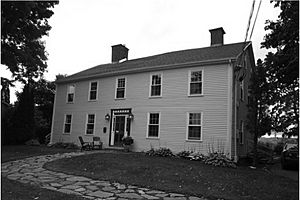New England Planters facts for kids
The New England Planters were early settlers from the New England colonies. They moved to Nova Scotia because they were invited by the governor, Charles Lawrence. They settled on lands that became empty after the Acadians were forced to leave during the Bay of Fundy Campaign in 1755.
Contents
A New Home in Nova Scotia
About 8,000 Planters, which was roughly 2,000 families, arrived in Nova Scotia between 1759 and 1768. They came to take advantage of the offer of new land. Most of these settlers were farmers and fishermen.
Where Did They Settle?
The farmers mainly settled on the rich farmlands of the Annapolis Valley. They also moved to the southern parts of what is now New Brunswick, which was then part of Nova Scotia. Most of the fishermen went to the South Shore of Nova Scotia. They received the same amount of land as the farmers. Many fishermen wanted to move there because they were already fishing off the Nova Scotia coast.
Why Did People Move?
The move of these 2,000 families to Nova Scotia was part of a much larger movement. Many people were moving to other areas like New York's Mohawk River Valley, New Hampshire, Vermont, and Maine. From 1760 to 1775, many new towns were created in these areas, including 14 in Nova Scotia.
The main reason people moved was that land was hard to find in New England. The chance to get free land in Nova Scotia was very appealing. This move happened after the French power in North America was defeated between 1758 and 1760, making the area safer for new settlers.
Who Were the Planters?
The Planters were the first large group of English-speaking immigrants in Canada who did not come directly from Great Britain. Most of the Planters were Protestants, belonging to the Congregationalist church. This was different from the Catholic Acadians who had lived there before.
Building New Communities
The Planters in the Annapolis Valley brought back the special dykeland farming methods. These methods had been created by the Acadians. The Planters even expanded these methods with big projects like the Wellington Dyke.
Later, other groups joined the Planters. These included settlers from Ulster and Yorkshire in Britain. Also, United Empire Loyalists arrived after the American War of Independence in 1783. These Loyalists left New York and the New England colonies.
Planters' Lasting Impact
The arrival of these new groups reduced the Planters' political power in Nova Scotia. However, the Planters had already built the foundations for many communities that still exist today in Nova Scotia and New Brunswick. Their political and religious traditions, like those of Henry Alline, greatly influenced the culture of the region.
In Nova Scotia, the New England Planters even inspired the provincial nickname "Bluenoser." This term was first used to tell the difference between Planter candidates and Loyalist candidates in elections after the American Revolution.
Today, the Planters are studied a lot by historians. There have been several Planters Studies conferences at Acadia University in Wolfville, Nova Scotia. They are also remembered at a Parks Canada exhibit at the Kings County Museum in Kentville, Nova Scotia.
Notable people
- Robert Denison
- Henry Alline
- Samuel Starr
- Gamaliel Smethurst


